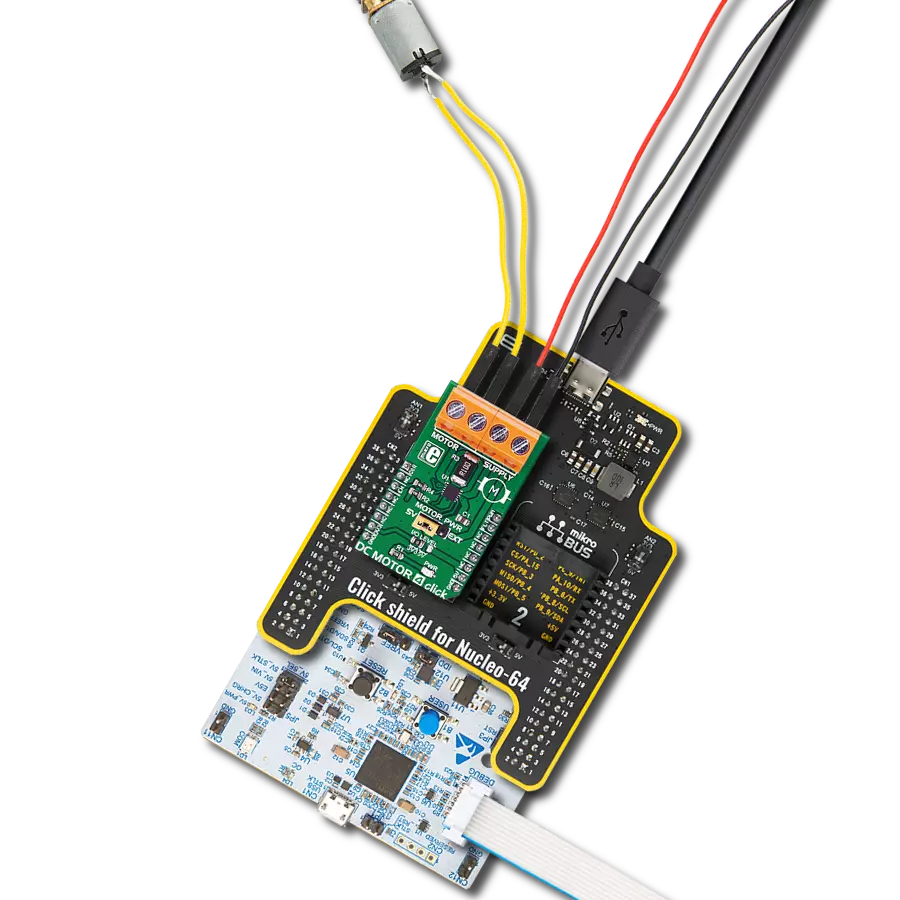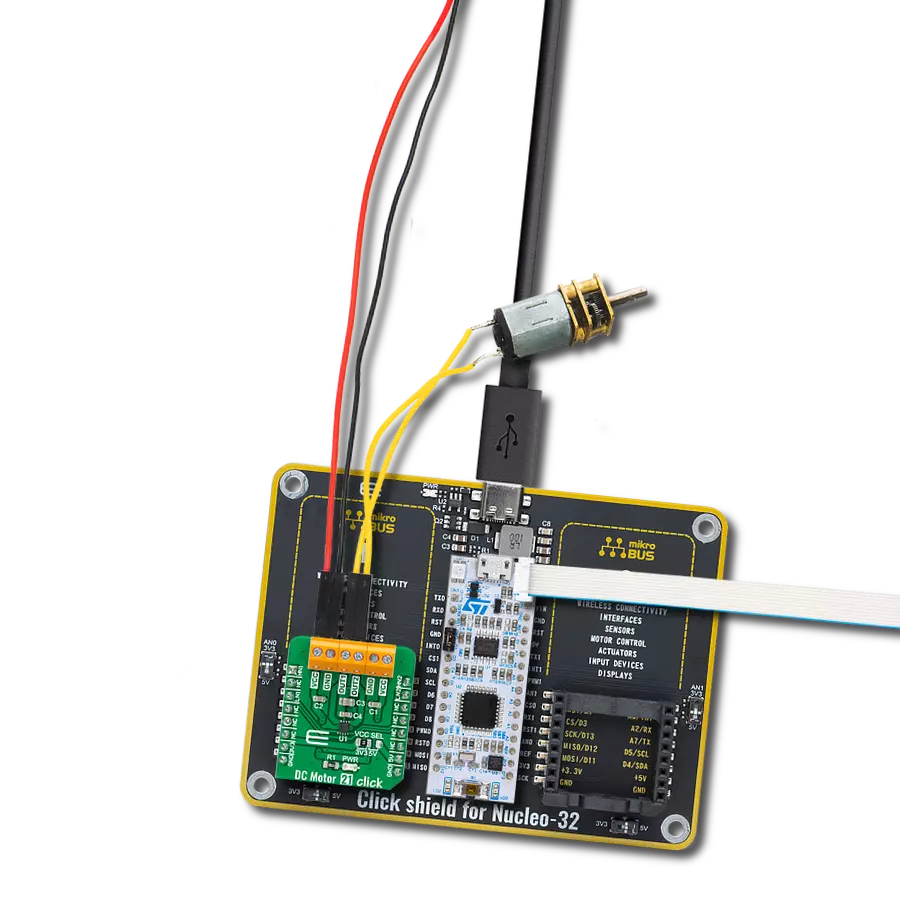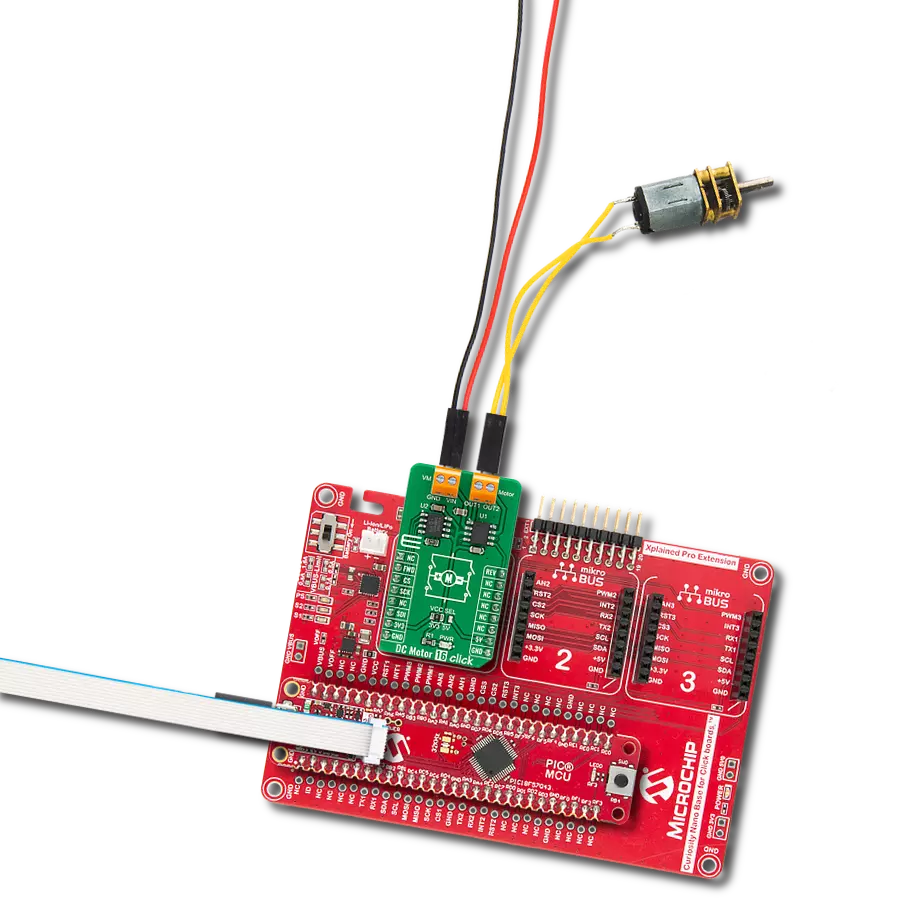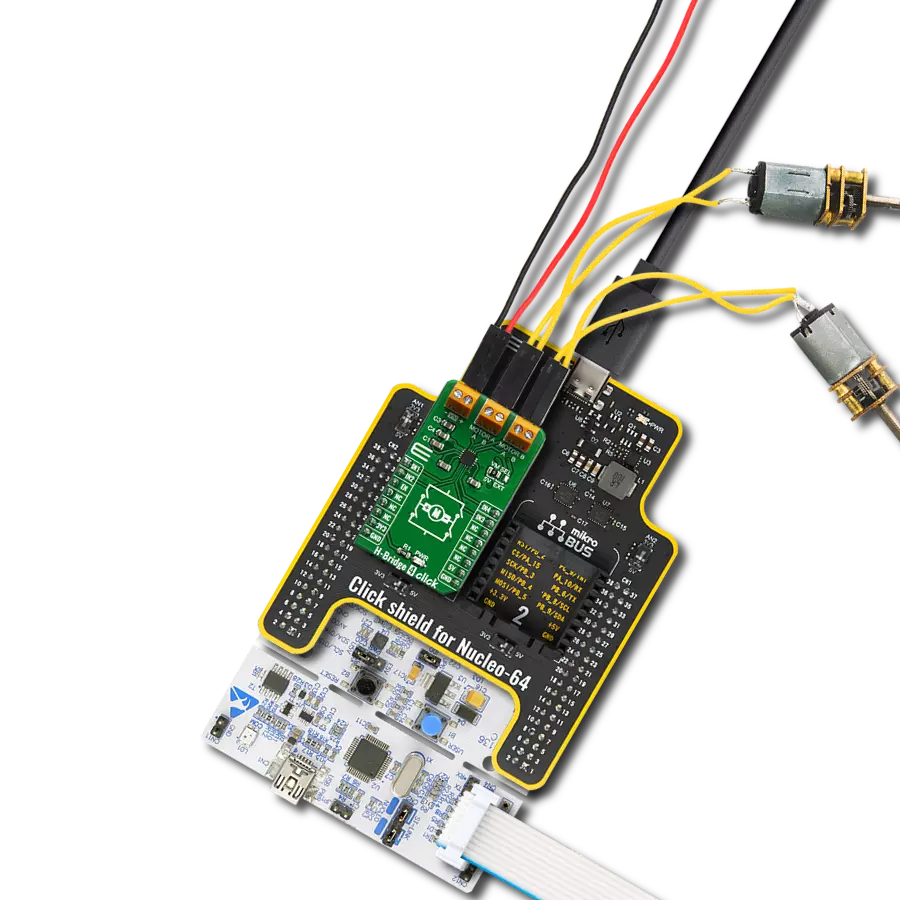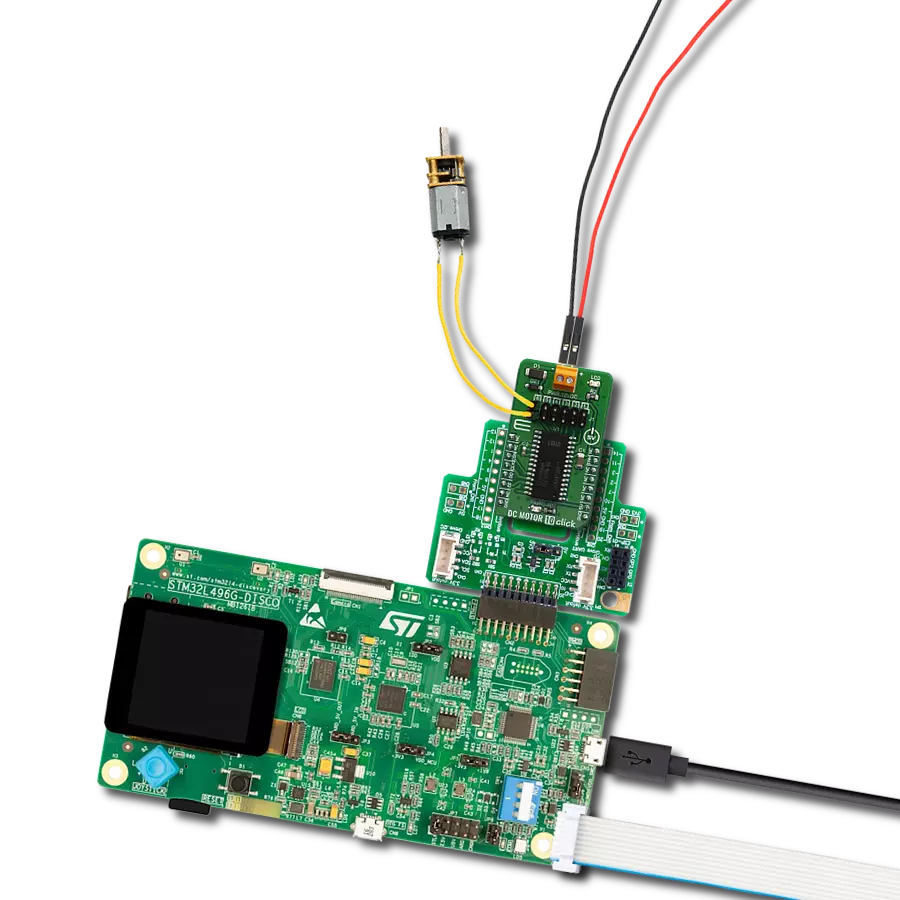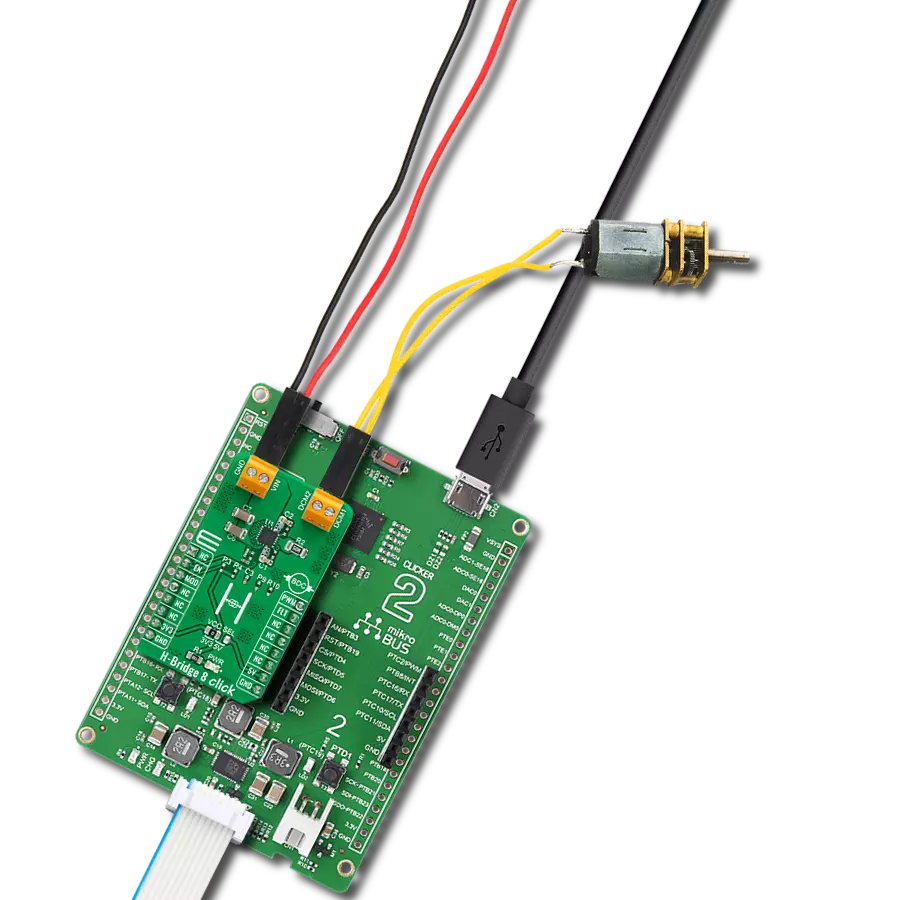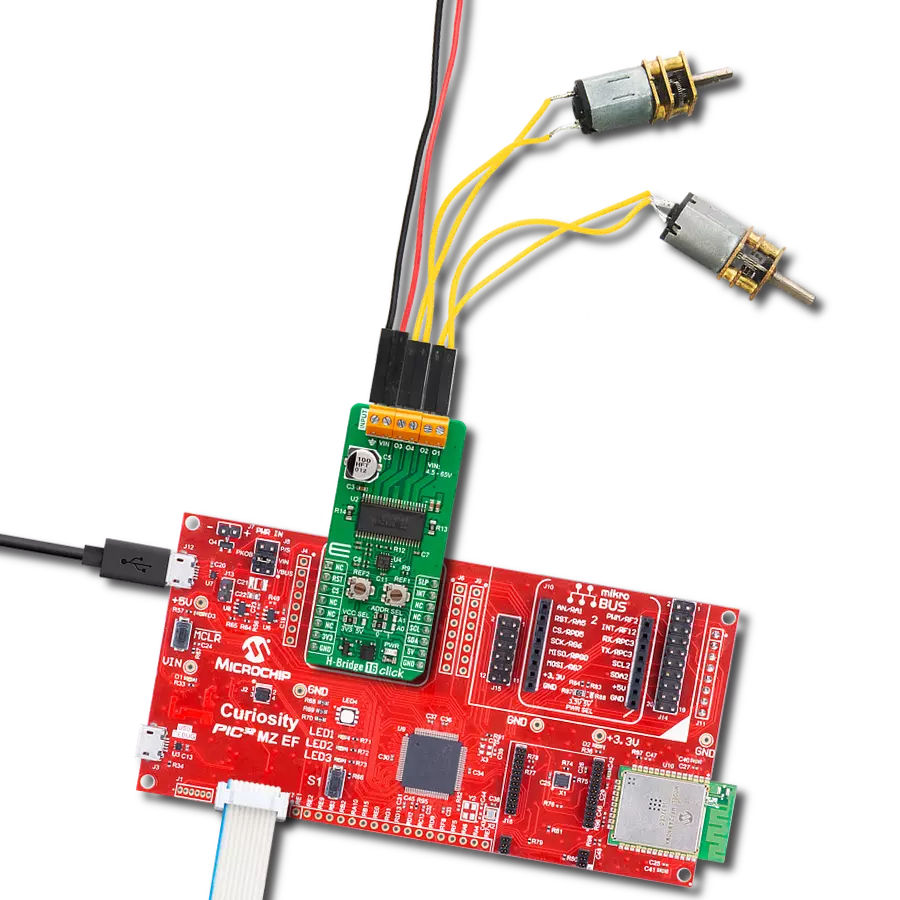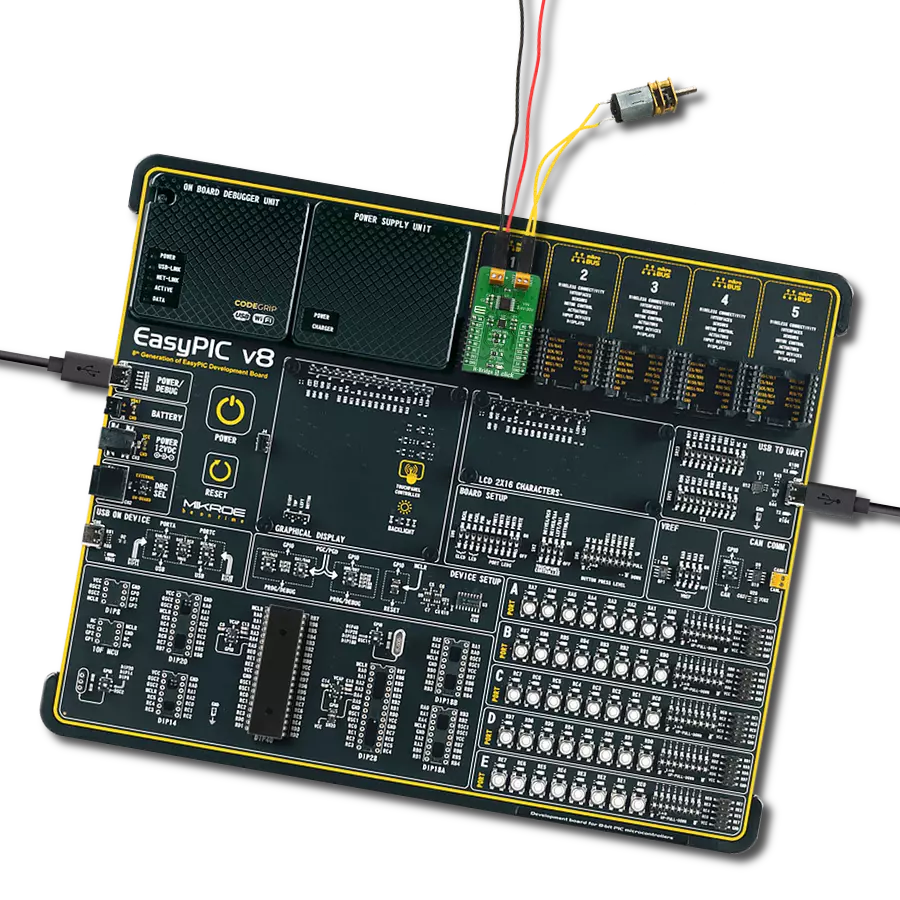Compact, user-friendly solution for controlling brushed DC motors with minimal fuss and maximum reliability
A
A
Hardware Overview
How does it work?
DC MOTOR Click is based on the DRV8833, an H-bridge motor driver with current-control PWM circuitry from Texas Instruments. The DRV8833 has two integrated H-bridges connected in parallel for double the current of a single H-bridge rated for an operating voltage range from 3V to 10V. The output driver block of the DRV8833 consists of N-channel power MOSFETs configured as an H-bridge to drive the motor windings, where each H-bridge includes circuitry to regulate or limit the winding current. Thanks to the current sense resistors R2 and R5 of 220mΩ, the driving current is limited to 0.9A. In addition, the 74HC4053 is also incorporated into the design to run the motor with only one PWM line from the mikroBUS™ socket. Thanks to this multiplexer, in combination with the selection pins
SL1 and SL2, routed to the RST and CS pins of the mikroBUS™ socket, control of the DRV8833 driver as well as management of its operating modes (Coast/Fast Decay, Reverse, Forward, Brake/Slow Decay) is enabled. This mux can also be used for PWM control of the motor speed. The DRV8833 also has a complete set of diagnostic and protection capabilities that support robust and reliable operation, like over-current protection, short circuit protection, undervoltage lockout, and overtemperature. In any case, the user can also visually detect them, in addition to the FLT pin, through the red LED marked with FAULT. It is also possible to set the driver in low-power Sleep mode via the SLP pin routed to the AN pin of the mikroBUS™ socket. In this state, the H-bridges are
disabled, the gate drive charge pump is stopped, all internal logic is reset, and all internal clocks are stopped. This Click board™ can operate with both 3.3V and 5V logic voltage levels selected via the PWR SEL jumper. It allows both 3.3V and 5V capable MCUs to use the communication lines properly. Additionally, there is a possibility for the DRV8833 power supply selection via jumper labeled as MOTOR PWR to supply the DRV8833 from an external power supply terminal from 3V to 10V or from mikroBUS™ power rails. However, the Click board™ comes equipped with a library containing easy-to-use functions and an example code that can be used, as a reference, for further development.
Features overview
Development board
PIC18F57Q43 Curiosity Nano evaluation kit is a cutting-edge hardware platform designed to evaluate microcontrollers within the PIC18-Q43 family. Central to its design is the inclusion of the powerful PIC18F57Q43 microcontroller (MCU), offering advanced functionalities and robust performance. Key features of this evaluation kit include a yellow user LED and a responsive
mechanical user switch, providing seamless interaction and testing. The provision for a 32.768kHz crystal footprint ensures precision timing capabilities. With an onboard debugger boasting a green power and status LED, programming and debugging become intuitive and efficient. Further enhancing its utility is the Virtual serial port (CDC) and a debug GPIO channel (DGI
GPIO), offering extensive connectivity options. Powered via USB, this kit boasts an adjustable target voltage feature facilitated by the MIC5353 LDO regulator, ensuring stable operation with an output voltage ranging from 1.8V to 5.1V, with a maximum output current of 500mA, subject to ambient temperature and voltage constraints.
Microcontroller Overview
MCU Card / MCU

Architecture
PIC
MCU Memory (KB)
128
Silicon Vendor
Microchip
Pin count
48
RAM (Bytes)
8196
You complete me!
Accessories
Curiosity Nano Base for Click boards is a versatile hardware extension platform created to streamline the integration between Curiosity Nano kits and extension boards, tailored explicitly for the mikroBUS™-standardized Click boards and Xplained Pro extension boards. This innovative base board (shield) offers seamless connectivity and expansion possibilities, simplifying experimentation and development. Key features include USB power compatibility from the Curiosity Nano kit, alongside an alternative external power input option for enhanced flexibility. The onboard Li-Ion/LiPo charger and management circuit ensure smooth operation for battery-powered applications, simplifying usage and management. Moreover, the base incorporates a fixed 3.3V PSU dedicated to target and mikroBUS™ power rails, alongside a fixed 5.0V boost converter catering to 5V power rails of mikroBUS™ sockets, providing stable power delivery for various connected devices.
DC Gear Motor - 430RPM (3-6V) represents an all-in-one combination of a motor and gearbox, where the addition of gear leads to a reduction of motor speed while increasing the torque output. This gear motor has a spur gearbox, making it a highly reliable solution for applications with lower torque and speed requirements. The most critical parameters for gear motors are speed, torque, and efficiency, which are, in this case, 520RPM with no load and 430RPM at maximum efficiency, alongside a current of 60mA and a torque of 50g.cm. Rated for a 3-6V operational voltage range and clockwise/counterclockwise rotation direction, this motor represents an excellent solution for many functions initially performed by brushed DC motors in robotics, medical equipment, electric door locks, and much more.
Used MCU Pins
mikroBUS™ mapper
Take a closer look
Click board™ Schematic

Step by step
Project assembly
Software Support
Library Description
This library contains API for DC MOTOR Click driver.
Key functions:
dcmotor_pwm_start- Start PWM module.dcmotor_enable- Enable the motor function.dcmotor_sleep_mode- Set sleep mode function.
Open Source
Code example
The complete application code and a ready-to-use project are available through the NECTO Studio Package Manager for direct installation in the NECTO Studio. The application code can also be found on the MIKROE GitHub account.
/*!
* \file
* \brief DcMotor Click example
*
* # Description
* This application change the speed and direction of DC Motor.
*
* The demo application is composed of two sections :
*
* ## Application Init
* Initialization driver enable's - GPIO,
* PWM initialization, set PWM duty cycle and PWM frequency, enable the motor, start PWM and start write log.
*
* ## Application Task
* This is a example which demonstrates the use of DC Motor Click board.
* DC Motor Click communicates with register via PWM interface.
* It shows moving in the left direction from slow to fast speed
* and from fast to slow speed.
* Results are being sent to the Usart Terminal where you can track their changes.
*
* \author Nikola Peric
*
*/
// ------------------------------------------------------------------- INCLUDES
#include "board.h"
#include "log.h"
#include "dcmotor.h"
// ------------------------------------------------------------------ VARIABLES
static dcmotor_t dcmotor;
static log_t logger;
uint8_t dcmotor_direction = 1;
void application_init ( void )
{
log_cfg_t log_cfg;
dcmotor_cfg_t cfg;
/**
* Logger initialization.
* Default baud rate: 115200
* Default log level: LOG_LEVEL_DEBUG
* @note If USB_UART_RX and USB_UART_TX
* are defined as HAL_PIN_NC, you will
* need to define them manually for log to work.
* See @b LOG_MAP_USB_UART macro definition for detailed explanation.
*/
LOG_MAP_USB_UART( log_cfg );
log_init( &logger, &log_cfg );
log_info( &logger, "---- Application Init ----" );
// Click initialization.
dcmotor_cfg_setup( &cfg );
DCMOTOR_MAP_MIKROBUS( cfg, MIKROBUS_1 );
dcmotor_init( &dcmotor, &cfg );
log_printf( &logger, " Initialization PWM \r\n" );
dcmotor_set_duty_cycle ( &dcmotor, 0.0 );
dcmotor_pwm_start( &dcmotor );
log_printf( &logger, "---------------------\r\n" );
}
void application_task ( )
{
static int8_t duty_cnt = 1;
static int8_t duty_inc = 1;
float duty = duty_cnt / 10.0;
if ( dcmotor_direction == 1 )
{
dcmotor_sleep_mode ( &dcmotor );
dcmotor_right_direction_slow ( &dcmotor );
log_printf( &logger, "> CLOCKWISE <\r\n" );
dcmotor_enable ( &dcmotor );
}
else
{
dcmotor_sleep_mode ( &dcmotor );
dcmotor_left_direction_slow ( &dcmotor );
log_printf( &logger, "> COUNTER CLOCKWISE <\r\n" );
dcmotor_enable ( &dcmotor );
}
dcmotor_set_duty_cycle ( &dcmotor, duty );
Delay_ms ( 500 );
if ( 10 == duty_cnt )
{
duty_inc = -1;
if ( dcmotor_direction == 1 )
{
dcmotor_direction = 0;
}
else if ( dcmotor_direction == 0 )
{
dcmotor_direction = 1;
}
}
else if ( 0 == duty_cnt )
{
duty_inc = 1;
}
duty_cnt += duty_inc;
}
int main ( void )
{
/* Do not remove this line or clock might not be set correctly. */
#ifdef PREINIT_SUPPORTED
preinit();
#endif
application_init( );
for ( ; ; )
{
application_task( );
}
return 0;
}
// ------------------------------------------------------------------------ END
Additional Support
Resources
Category:Brushed





















